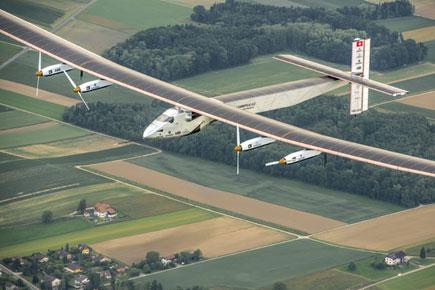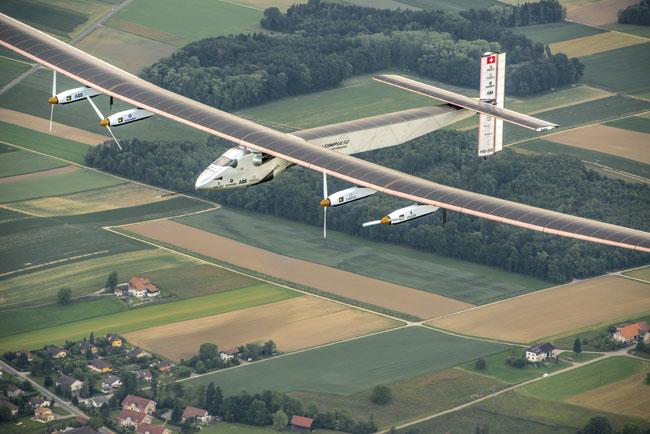Solar Impulse 2 is poised to create history in March 2015 by circumnavigating the globe without a single drop of oil as its only source of fuel will be the sun

Laussane (Switzerland): Inside a military hangar at Payerne in the French speaking part of Switzerland is parked a plane that is poised to create history in March 2015 by circumnavigating the globe without a single drop of oil. Its only source of fuel will be the sun.
![]()
ADVERTISEMENT
Solar Impulse 2 is a single-pilot plane with a 72-metre wingspan (wider than a Boeing 747 but a little smaller than an Airbus A-380) and will land in Ahmedabad and Varanasi in the first week of March, the same day it will take off from Abu Dhabi in the United Arab Emirates. It will make eight or nine more landings in three more countries, including China and the United States.

Solar Impulse 2 flying over Payerne area. Pic: Solar Impulse
While the organizers are still to receive a formal okay from Indian authorities to land, the Swiss co-founders of Solar Impulse - businessman André Borschberg and psychiatrist and adventurist Bertrand Piccard. The latter is best known for co-piloting the first round-the-world non-stop balloon ride in 1999.
Together, Borschberg and Piccard with their multi-country team, developed the plane after spending close to 150 million euros over 13 years. Despite its size, Solar Impulse 2's weight is a mere 2300 kg, slightly more than a standard four-wheel-drive SUV.
![]()
"Our real challenge is the human factor," said Borschberg on Monday. "Since the pilot will fly close to 120 hours at a stretch, there will be multiple problems to deal with. Sleep, for instance, has been planned."

From left to right: Dr Sultan Ahmed Al Jaber (Minister of State in the United Arab Emirates and Chairman of Masdar), Bertrand Piccard (Initiator, Chairman and Pilot of Solar Impulse), HH Sheikh Abdullah bin Zayed bin Sultan Al Nahyan (United Arab Emirates Minister of Foreign Affairs), HE Ambassador Lana Nusseibeh (Permanent Representative of the United Arab Emirates to the United Nations), André Borschberg (co-founder, CEO and Pilot of Solar Impulse). Pic: Solar Impulse
Piccard, who along with Borschberg will pilot the flight, said they will have to sleep for 20 minutes and then stay awake for 20 more. "We have worked closely with Indian yoga expert Sanjiv Bhanot to develop sleep-and-awake patterns so that the pilot and the plane are not jeopardised."
Another Indian, Srinivasan Murali, a Stanford graduate and a PhD alumnus of Ecole Polytechnique Federale de Lausanne (EPFL), a leading Swiss university that is partnering Solar Impulse 2, has developed a portable ECG monitoring device that the pilot can use for real-time analysis. Dr Murali's startup, SmartCardia, will work closely with Solar Impulse 2 to keep the pilot (and other planes) out of danger especially during landing.
"The pilot can hold the device in his hand or just strap it on his chest for real-time analysis of his heart," he told mid-day. "Based on the readings, we can change the landing time if needed. This is not only to keep the Solar Impulse 2 pilot safe, but also other commercial planes especially in airports with heavy traffic."
Dr Piccard said apart from the human challenge of the project, there is also weather to contend with. With five days and five nights over the Pacific Ocean and three days and three nights over the Atlantic, weather is most likely the biggest challenge for a lightweight plane. "We have leading meteorologists who will be monitoring weather in real-time and we will then alter the route based on our readings and predictions," Dr Piccard said. "From Abu Dhabi to Ahmedabad alone will take us 15 hours. Weather patterns, therefore, are of serious concern to us, but we hope to overcome the challenges with some smart planning."
The Solar Impulse project had its first test flight across the United States in 2013 and even managed to land in the busy John F Kennedy airport in Newark, New Jersey. "This was proof of concept," Borschberg told mid-day. "To land at one of the world's busiest airports was an important landmark for us." Piccard added, "It is a new paradigm."
There is no immediate commercial application of the solar plane, the founders assert. "It is a single-seater plane with a non-pressurised cabin. We rely on supplementary oxygen for the pilot to survive," Borschberg said. "It can fly at an average speed of 100 kmph, so intercontinental commercial flights are still a long way away."
Since the plane works purely on solar energy, it has some flying limitations as well. For example, if it can fly at 8,500 metres above sea level during the day, it lowers to an altitude of 3000 metres at night. "It is to conserve energy," said Dr Piccard.
Though there is a lot of progress on the project with multiple international partners led by the Belgian company Solvay leading it, there have been hiccups. For example, a minor structural failure delayed the project, and while the initial circumnavigation was planned for 2014, it was pushed to the first quarter of 2015.
But both Piccard and Borschberg are confident that their new plane will deliver in March. "It's not easy, and if it were, nobody would care," Piccard said. "We need to get rid of the old habits and old beliefs. We need to free our minds to create new solutions. It is the beginning of a new paradigm."
 Subscribe today by clicking the link and stay updated with the latest news!" Click here!
Subscribe today by clicking the link and stay updated with the latest news!" Click here!







